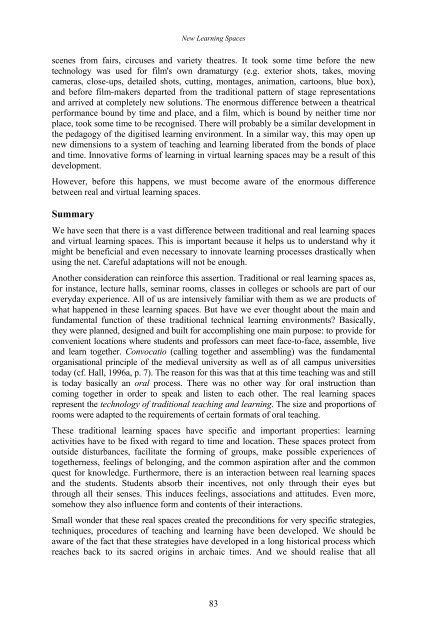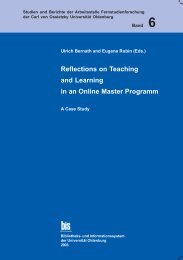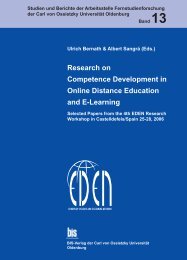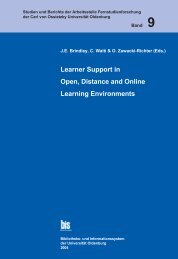Distance Education in Transition - Master of Distance Education ...
Distance Education in Transition - Master of Distance Education ...
Distance Education in Transition - Master of Distance Education ...
Create successful ePaper yourself
Turn your PDF publications into a flip-book with our unique Google optimized e-Paper software.
New Learn<strong>in</strong>g Spaces<br />
scenes from fairs, circuses and variety theatres. It took some time before the new<br />
technology was used for film's own dramaturgy (e.g. exterior shots, takes, mov<strong>in</strong>g<br />
cameras, close-ups, detailed shots, cutt<strong>in</strong>g, montages, animation, cartoons, blue box),<br />
and before film-makers departed from the traditional pattern <strong>of</strong> stage representations<br />
and arrived at completely new solutions. The enormous difference between a theatrical<br />
performance bound by time and place, and a film, which is bound by neither time nor<br />
place, took some time to be recognised. There will probably be a similar development <strong>in</strong><br />
the pedagogy <strong>of</strong> the digitised learn<strong>in</strong>g environment. In a similar way, this may open up<br />
new dimensions to a system <strong>of</strong> teach<strong>in</strong>g and learn<strong>in</strong>g liberated from the bonds <strong>of</strong> place<br />
and time. Innovative forms <strong>of</strong> learn<strong>in</strong>g <strong>in</strong> virtual learn<strong>in</strong>g spaces may be a result <strong>of</strong> this<br />
development.<br />
However, before this happens, we must become aware <strong>of</strong> the enormous difference<br />
between real and virtual learn<strong>in</strong>g spaces.<br />
Summary<br />
We have seen that there is a vast difference between traditional and real learn<strong>in</strong>g spaces<br />
and virtual learn<strong>in</strong>g spaces. This is important because it helps us to understand why it<br />
might be beneficial and even necessary to <strong>in</strong>novate learn<strong>in</strong>g processes drastically when<br />
us<strong>in</strong>g the net. Careful adaptations will not be enough.<br />
Another consideration can re<strong>in</strong>force this assertion. Traditional or real learn<strong>in</strong>g spaces as,<br />
for <strong>in</strong>stance, lecture halls, sem<strong>in</strong>ar rooms, classes <strong>in</strong> colleges or schools are part <strong>of</strong> our<br />
everyday experience. All <strong>of</strong> us are <strong>in</strong>tensively familiar with them as we are products <strong>of</strong><br />
what happened <strong>in</strong> these learn<strong>in</strong>g spaces. But have we ever thought about the ma<strong>in</strong> and<br />
fundamental function <strong>of</strong> these traditional technical learn<strong>in</strong>g environments? Basically,<br />
they were planned, designed and built for accomplish<strong>in</strong>g one ma<strong>in</strong> purpose: to provide for<br />
convenient locations where students and pr<strong>of</strong>essors can meet face-to-face, assemble, live<br />
and learn together. Convocatio (call<strong>in</strong>g together and assembl<strong>in</strong>g) was the fundamental<br />
organisational pr<strong>in</strong>ciple <strong>of</strong> the medieval university as well as <strong>of</strong> all campus universities<br />
today (cf. Hall, 1996a, p. 7). The reason for this was that at this time teach<strong>in</strong>g was and still<br />
is today basically an oral process. There was no other way for oral <strong>in</strong>struction than<br />
com<strong>in</strong>g together <strong>in</strong> order to speak and listen to each other. The real learn<strong>in</strong>g spaces<br />
represent the technology <strong>of</strong> traditional teach<strong>in</strong>g and learn<strong>in</strong>g. The size and proportions <strong>of</strong><br />
rooms were adapted to the requirements <strong>of</strong> certa<strong>in</strong> formats <strong>of</strong> oral teach<strong>in</strong>g.<br />
These traditional learn<strong>in</strong>g spaces have specific and important properties: learn<strong>in</strong>g<br />
activities have to be fixed with regard to time and location. These spaces protect from<br />
outside disturbances, facilitate the form<strong>in</strong>g <strong>of</strong> groups, make possible experiences <strong>of</strong><br />
togetherness, feel<strong>in</strong>gs <strong>of</strong> belong<strong>in</strong>g, and the common aspiration after and the common<br />
quest for knowledge. Furthermore, there is an <strong>in</strong>teraction between real learn<strong>in</strong>g spaces<br />
and the students. Students absorb their <strong>in</strong>centives, not only through their eyes but<br />
through all their senses. This <strong>in</strong>duces feel<strong>in</strong>gs, associations and attitudes. Even more,<br />
somehow they also <strong>in</strong>fluence form and contents <strong>of</strong> their <strong>in</strong>teractions.<br />
Small wonder that these real spaces created the preconditions for very specific strategies,<br />
techniques, procedures <strong>of</strong> teach<strong>in</strong>g and learn<strong>in</strong>g have been developed. We should be<br />
aware <strong>of</strong> the fact that these strategies have developed <strong>in</strong> a long historical process which<br />
reaches back to its sacred orig<strong>in</strong>s <strong>in</strong> archaic times. And we should realise that all<br />
83





